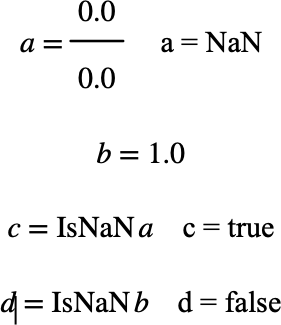\(\text{IsNaN}\)¶
You can use the \(\text{IsNaN}\) function to determine if a real value is
NaN or ‘not a number’.
You can use the \isnan backslash command to insert this function.
The following variants of this function are available:
\(\text{boolean } \text{IsNaN} \left ( \text{<value>} \right )\)
Functions and operators will result in NaN under the following
circumstances:
Cases where the operator or function’s value is undefined. Example would be the result of \(\frac{0}{0}\).
Cases where a function is not defined for the value of one or more supplied parameters.
Certain error conditions.
Figure 161 shows the basic use of the \(\text{IsNaN}\) function.

Figure 161 Example Use Of The IsNaN Function¶
